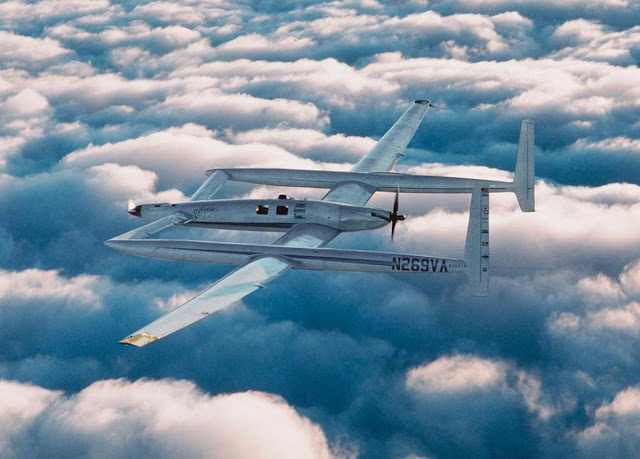In 1986, the Rutan Model 76 Voyager became the first aircraft to fly successfully around the world non-stop and without refueling. It was flown by Dick Rutan, a former fighter pilot and test pilot of the United States Air Force and Jeana Yeager, a record-setting pilot in her own right.
The flight was approved by the Fédération Aéronautique Internationale (FAI). It took off from Edwards Air Force Base in the Mojave Desert on December 14, 1986 and ended at the same place nine days, three minutes and 44 seconds later on December 23. In the process, it set eight world-class records, including a new flight endurance record. The unique aircraft which was built almost entirely of light weight graphite-honeycomb composite materials, flew westerly 26,366 statute miles (42,432 km; the FAI accredited distance is 40,212 km) at an average altitude of 11,000 feet (3,350 m).
The aircraft was first imagined by Burt Rutan and Burt’s brother Dick Rutan in 1980. Burt sketched his concept for the aircraft for Dick and Jeana Yeager during a lunch in 1981. The idea was sketched out on the back of a napkin. Voyager was built in Mojave, California over a period of five years, mainly by volunteers working under both the Rutan Aircraft Factory and an organization named Voyager Aircraft. Burt Rutan served as the lead designer for the project.
The airframe made of fiberglass, carbon fiber, and Kevlar weighed 939 pounds (426 kg) when empty. With the engines included, the unladen weight of the plane was 2,250 pounds (1,020 kg). However, when it was fully loaded before the historic flight it weighed 9,694.5 pounds (4,397.4 kg) due to the amount of fuel required for the long-distance flight.
Voyager’s world flight takeoff took place on the longest runway at Edwards AFB at 8:01 am local time on December 14, 1986, with 3,500 of the world’s press in attendance. As the plane accelerated, the tips of the wings, which were heavily loaded with fuel, were damaged as they unexpectedly flew down and scraped against the runway, ultimately causing pieces (winglets) to break off at both ends. The aircraft accelerated very slowly and needed approximately 14,200 feet (2.7 mi; 4.3 km) of the runway to gain enough speed to lift from the ground, the wings arching up dramatically just before take-off. The two damaged winglets remained attached to the wings by only a thin layer of carbon fiber and were removed by flying the Voyager in a slip, which introduced side-loading, tearing the winglets off completely. Some of the carbon fiber skin was pulled off in the process, exposing the blue foam core. Burt Rutan following with pilot Mike Melvill determined that Voyager was still within its performance specifications despite the damage and decided to allow the flight to continue.
During the flight, the two pilots had to deal with extremely cramped quarters. To reduce stress, the two had originally intended to fly the plane in three-hour shifts, but flight handling characteristics while the plane was heavy prevented routine changeovers, and they became very fatigued. Dick Rutan reportedly stayed at the controls without relief for almost the first three days of the flight.
The plane also continuously reminded the pilots of its pitch instability and fragility. They had to maneuver around bad weather numerous times, most perilously around the 600-mile-wide (1,000 km) Typhoon Marge. Libya denied access to the country’s airspace in response to Operation El Dorado Canyon earlier that year. There were contentious radio conversations between the Rutan brothers as Dick flew around weather and, at one time, turned around and began doubling back. As they neared California to land, a fuel pump failed and had to be replaced with its twin pumping fuel from the other side of the aircraft.
In front of 55,000 spectators and a large press contingent, including 23 live feeds breaking into scheduled broadcasting across Europe and North America, the plane safely came back to earth, touching down at 8:06 a.m. at the same airfield 9 days after take-off.
For this epic achievement, the Rutan brothers, Jeana Yeager and crew chief Bruce Evans received the 1986 Collier Trophy. A similar feat has since been accomplished only once, in March 2006, by Steve Fossett flying the Virgin Atlantic Global Flyer, also designed by Burt Rutan.





















0 comments:
Post a Comment